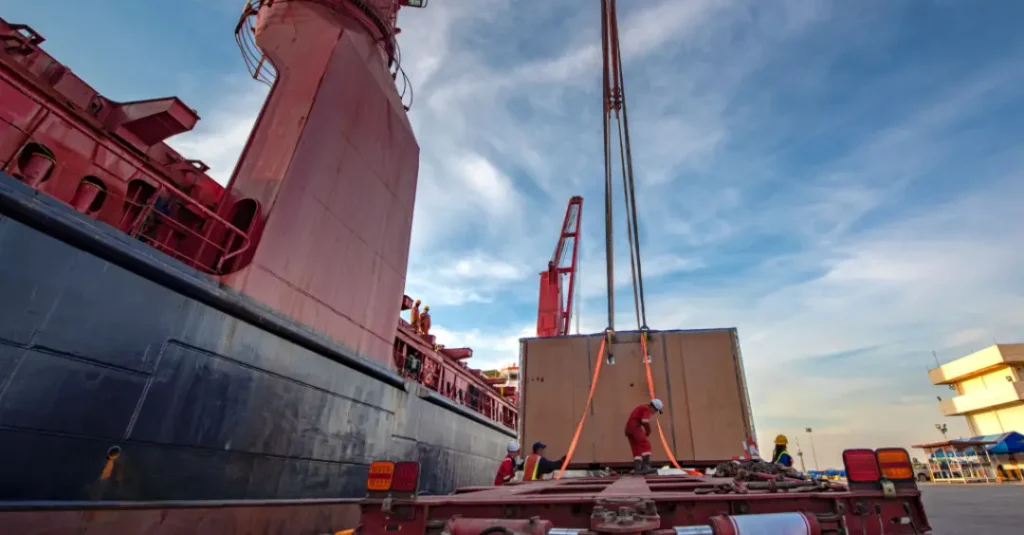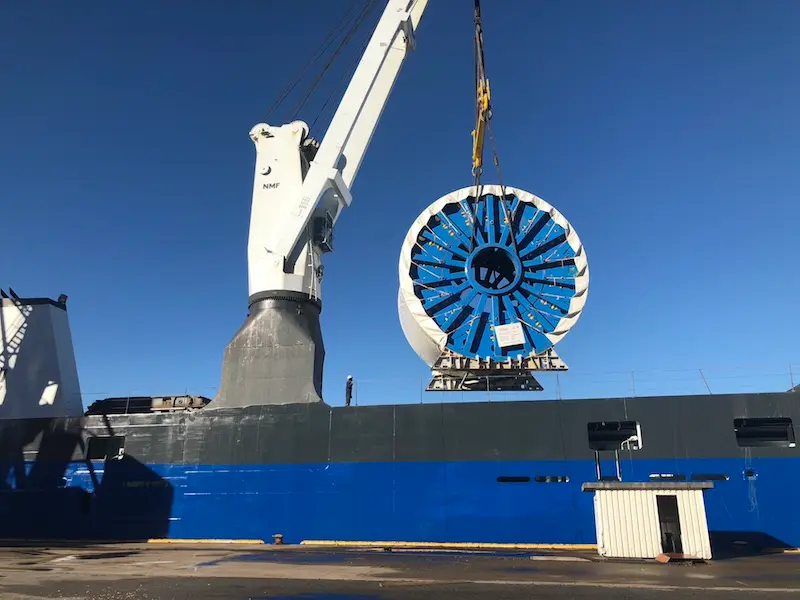Navigating the Basics of Project Cargo Logistics is crucial in today’s global trade landscape, where the efficient and safe transportation of oversized and heavy-lift cargo plays a pivotal role.
The complexity of managing such logistics not only demands a deep understanding of various technical aspects but also requires meticulous planning and risk management.
This article delves into the intricate world of project cargo logistics, offering a roadmap for professionals and enthusiasts alike to understand and overcome the unique challenges posed by this specialized field.
What is Project Cargo?
In the realm of maritime logistics, project cargo stands as a distinct category, defined by its non-standard nature. This term generally refers to cargo that is too large or heavy to fit within standard shipping containers or cargo bins.

These are the freight loads that challenge traditional logistics due to their size, weight, or complexity. Key types of project cargo include:
- Heavy-Lift: This type typically involves items over 100 tons, such as large equipment or machinery, requiring specialized lifting and handling methods. For example, items like turbines or generators used in energy projects.
- Oversized Loads: These are cargoes that exceed standard dimensions in length, width, or height. Think of windmill blades, industrial parts, or large vehicles.
- Specialized Vessels: Certain project cargoes necessitate the use of unique vessels, like semi-submersible ships for floating cargo or open-deck carriers for tall structures.
What are Key Characteristics of Project Cargo?
Project cargo distinguishes itself from regular cargo through several unique aspects:
- Special Handling: The complexity and size of project cargo often require custom handling solutions. This involves specialized equipment, skilled manpower, and sometimes, unique transportation routes.
- Transportation Challenges: Moving such cargo presents logistical puzzles. Coordinating between different transportation modes (land, sea, air), navigating regulatory landscapes, and maintaining cargo integrity are just a few challenges.
- Safety Regulations: Adhering to strict safety standards is paramount in project cargo logistics. Every phase, from loading to transportation to unloading, must comply with national and international safety regulations to mitigate risks.
Planning and Preparation in Project Cargo Logistics
Route Planning and Risk Assessment
The success of transporting project cargo heavily relies on meticulous route planning and thorough risk assessment. Every project cargo operation begins with a detailed Route Analysis to identify the most efficient and safest path. This analysis takes into account factors like infrastructure limitations, geopolitical scenarios, and environmental considerations.
Key components of route planning and risk assessment include:
- Feasibility Studies: These are conducted to assess the practicality of the proposed routes and identify potential obstacles.
- Transportation Analysis: A comprehensive examination of all the logistics involved, including transit times, port capabilities, and inland transportation.
- Risk Mitigation: Developing strategies to minimize risks associated with the transport, such as weather-related delays, political unrest, or technical failures.
Effective Logistics Risk Assessment is not just about foreseeing challenges but also about being prepared with contingency plans. This proactive approach is vital in maintaining the integrity and schedule of the project.
Selecting the Right Equipment and Vessel
Choosing the right equipment and vessel is paramount in project cargo logistics, as the nature of the cargo often demands specialized handling and transportation methods. This decision-making process involves evaluating the specific requirements of the cargo, including weight, size, and sensitivity.

Aspects to consider in equipment and vessel selection are:
- Specialized Equipment: This ranges from high-capacity cranes for loading and unloading to custom-engineered trailers for land transport.
- Heavy-lift Vessels: These are specially designed to carry extraordinarily heavy loads, often equipped with their own cranes and reinforced decks. Here are the top 10 largest heavy lift ships in the world.
- Transportation Modes: Determining the most suitable mode of transportation, be it sea, air, or land, based on the cargo’s characteristics and destination.
The process of Choosing Project Cargo Equipment and vessels is a critical step in ensuring the cargo’s safety and the project’s overall success. Each piece of equipment and choice of vessel plays a crucial role in the complex orchestration of project cargo logistics.
Execution and Challenges
Loading and Unloading Operations
The loading and unloading of project cargo are critical stages that involve intricate operations and meticulous attention to detail. This phase requires not just physical handling of the cargo but also a well-coordinated effort between various teams and equipment.
Key aspects of loading and unloading operations include:
- Crane Operations: Utilizing specialized cranes capable of handling the heavy and oversized nature of project cargo. This involves careful planning to ensure stability and safety throughout the lifting process.
- Dockside Logistics: Coordinating the movement of cargo at the port, which includes space management, equipment readiness, and timely execution to avoid bottlenecks.
- Safety Protocols: Adhering to stringent safety measures to prevent accidents during heavy-lift operations. This includes thorough training of personnel and regular equipment checks.
Successful Project Cargo Loading and unloading demand a harmonious blend of skilled manpower, advanced equipment, and rigorous safety practices, making it a complex yet crucial component of project cargo logistics.
Project cargo logistics often encounter a variety of challenges, ranging from regulatory hurdles to unpredictable environmental conditions. Overcoming these challenges requires a blend of expertise, experience, and proactive planning.
Some common issues in project cargo logistics include:
- Regulatory Compliance: Navigating the complex web of international and local regulations, ensuring all necessary permits and clearances are obtained for the transport of oversized and heavy-lift cargo.
- Environmental Factors: Dealing with unforeseen weather conditions and environmental constraints that can impact transportation schedules and routes.
- Logistical Challenges: Managing the myriad logistical aspects, from route deviations to unexpected technical issues, requires agility and adaptability.
Addressing these Project Cargo Challenges involves a deep understanding of the logistics landscape and the ability to swiftly adapt to changing circumstances, ensuring the smooth execution of project cargo operations.
Key Industries Relying on Project Cargo Logistics
Energy and Power Generation
In the energy sector, project cargo logistics plays a pivotal role, especially in transporting large-scale equipment essential for power plants and renewable energy initiatives.
The transportation of wind turbine components, which are often oversized and require specialized handling, is a prime example of the complexities involved in this sector.
Similarly, the logistics of moving heavy equipment for offshore drilling rigs calls for a unique set of skills and resources. The coordination for such Power Generation Logistics involves not just physical transportation but also meticulous planning to ensure safety and efficiency.
Infrastructure and Construction
Project cargo is the backbone of the infrastructure and construction sector, facilitating the movement of materials critical for mega-projects. This includes the transport of large bridge sections, tunnel boring machines, and other heavy construction materials.
The logistics of moving such oversized items for Infrastructure Cargo Handling require precise coordination, from the planning stages to the final placement at construction sites. The success of these projects hinges on the ability to safely and efficiently handle and transport these large components.
Oil, Gas, and Petrochemicals
In the oil, gas, and petrochemical industries, the transportation of project cargo is a frequent and crucial activity. This includes moving large pipeline sections, refinery equipment, and oversized storage tanks.
The logistics challenges in these sectors are immense, involving not only the transport of heavy and oversized items but also ensuring compliance with stringent safety and environmental regulations. Successful Oil Industry Cargo Logistics is characterized by detailed planning, risk management, and the use of specialized equipment and vessels.
Marine Engineering and Shipbuilding
The marine engineering and shipbuilding sectors heavily rely on project cargo logistics for the transportation of large ship components, marine engines, and other significant parts used in shipbuilding and dry dock operations.
These industries require the movement of oversized and heavy items, often over great distances and sometimes under challenging conditions. Efficient Shipbuilding Logistics and handling are critical to the timely and cost-effective completion of marine projects, requiring expert knowledge and specialized equipment.
In each of these sectors, project cargo logistics stands as a critical component, enabling the transportation of vital equipment and materials necessary for major projects across the globe.
Case Studies and Best Practices
Real-World Examples of Successful Project Cargo Logistics
Exploring real-world examples offers invaluable insights into the practical aspects of project cargo logistics. These case studies demonstrate how innovative solutions, meticulous planning, and strategic execution lead to successful outcomes in complex logistics scenarios.
Prominent case studies include:
- Global Projects: Examining large-scale projects that involved transporting extraordinarily large or heavy items across continents, highlighting the logistical prowess and coordination required.
- Success Stories: Sharing narratives of challenging project cargo operations that were completed successfully, underscoring the importance of innovation and problem-solving in logistics.
- Innovative Solutions: Showcasing how unique challenges were overcome with creative and unconventional approaches in project management and logistics.
These Project Cargo Case Studies not only serve as a testament to the capabilities of the logistics industry but also provide practical lessons and strategies that can be applied in future projects.
Best Practices in Project Cargo Logistics
The culmination of experience and knowledge in the field of project cargo logistics has led to the establishment of best practices, which are essential for ensuring the safe, efficient, and successful handling of complex cargo.
Key best practices include:
- Adhering to Industry Standards: Maintaining high standards in every aspect of the logistics process, from planning to execution, ensures consistency and reliability in operations.
- Efficiency Tips: Implementing strategies to optimize operations, such as utilizing the latest technology and software for route planning and cargo tracking.
- Safety Measures: Prioritizing safety above all, with rigorous training for personnel, regular equipment inspections, and adherence to safety protocols.
Adopting these best practices in project cargo logistics not only enhances operational efficiency but also builds a foundation for continued success and growth in this challenging and dynamic field.
Conclusion
Understanding the basics of project cargo logistics is crucial in the dynamic maritime logistics sector. This article has navigated through the complexities and strategic nuances, from meticulous planning and execution to overcoming unique challenges.
As the industry evolves with technological advancements and shifting global trends, the strategic importance of mastering project cargo logistics becomes ever more critical.
Embracing these changes and adapting to future challenges is key for professionals in this field, ensuring continued growth and success in the intricate world of maritime cargo management.
- Types of Gas Carriers as per IGC Code – April 22, 2025
- Wind-Assisted Propulsion Systems (WAPS): A Game Changer for Maritime Decarbonization – February 6, 2025
- 10 Boat Salvage Yards in California – January 25, 2025



